 Searching for Fischey Bobber, Best Team Costume at the US Amateur Team North, Photo Betsy Dynako Zacate
Searching for Fischey Bobber, Best Team Costume at the US Amateur Team North, Photo Betsy Dynako Zacate The ever-growing Amateur Team North realized a 10 percent increase in entries over last year. The midwest event was represented by 10 different states this year, including Iowa, Ohio, Michigan, and as always there was a heavy showing by Wisconsin.
It has been a year since the untimely passing of Sevan Muradian (see obituary here at US Chess), but his standards of professional-style tournament direction lived on in many ways, including the supplying of boards and pieces. Bill Feldman co-organized this year with long-time host Glenn Panner.
NTD Glenn Panner said, “Chess Weekend would like to thank co-organizer Bill Feldman, and tournament directors Bob Messenger, Sam Shoykhet, and Donna Wallach. Our friends in New Jersey like to claim they have the largest team tournament, which they don’t, the honor belongs here in Illinois to our Illinois High School Association Team Tournament. We like to say we have the strongest team tournament, as evidenced by our North team winning it all last year, and the most fun!"
 Costumes at the US Amateur Team North, Photo Betsy Dynako Zacate
Costumes at the US Amateur Team North, Photo Betsy Dynako ZacatePanner failed to mention that the Amateur Team North could soon become long-term national team title holders, thanks to the growth of scholastic programs to support young players in the state of Illinois. The Warren Junior Scholar and Rising Star Program, programs sponsored by the Illinois Chess Association, have been providing free on-and-off-line training to qualified youth. The average age of one Amateur North Team, Grandmasters in Training, is seven years plus each player holds a national title. Each team member is also part of the Warren Junior Scholar and Rising Star Programs.
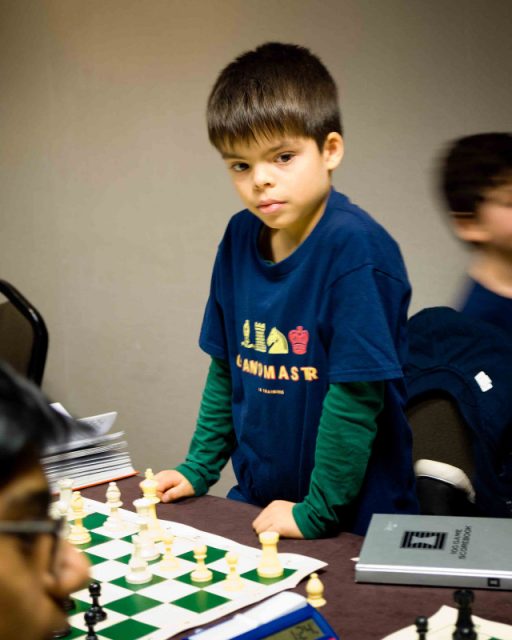 Dimitar Mardov of Grandmasters in Training, Photo Betsy Dynako Zacate
Dimitar Mardov of Grandmasters in Training, Photo Betsy Dynako ZacateIt was also good year for costumes and team names. Custom shirts and hats seemed to rule. Among the highlights: team Half Past Dead, a 50+ team who wore shirts that read, Time Expired; The Mad Hatters, who sported hats that included a food item and an emoji; and handmade shirts for team We are 42. Yet, best costume went to Searching for Fischey Bobber who wore custom shirts, fishing hats, complete with their own fishing poles and pail of gummy worms. Best team name, by popular vote, went to Black Openings Matter.
In the Saturday night Blitz tournament, 45 competitors took part. George Li of team Whitney Young Forever won first place.
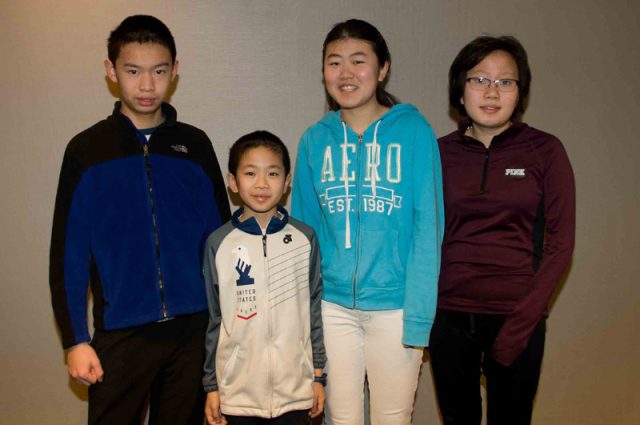 Team Gogica, top mixed doubles, Photo Betsy Dynako Zacate
Team Gogica, top mixed doubles, Photo Betsy Dynako Zacate In the main event, going into round four of five, there were two perfect scores and nine teams with 2.5 points. All eleven of those teams still had a chance at first place. Wisconsin has been sending top teams to the North tournament for many years, thanks to the Wisconsin Chess Academy, but this year both of their main teams fell in the fourth round. GM Josh Friedel annotated one such game, in which his opponent held a draw to clinch match victory.
[pgn] [Event "US Amateur Team North"]
[Site "?"]
[Date "2017.02.19"]
[White "Friedel, Joshua"]
[Black "Turgut, Aydin"]
[Result "1/2-1/2"]
[ECO "A80"]
[Annotator "GM Josh Friedel"]
[PlyCount "134"]
[EventDate "2017.??.??"]
[SourceDate "2017.02.24"]1. d4 f5 2. Nc3 Nf6 3. Bg5 d5 4. Bxf6 exf6 5. e3 Be6 6. Bd3 Qd7 7. Nge2 Nc6 8.
a3 O-O-O 9. Na4 {A strange looking move, but White wants to develop a
queenside attack with b4-Nc5 or challenge the center with b3-c4.} g5 {I like
this enterprising move. If Black plays slowly he'll just get trounced on the
queenside.} 10. f4 $2 {I was trying to put a stop to his kingside play, but
this is too loose} (10. O-O {was simpler and better, as it will take Black a
long time to develop a kingside attack.}) 10... Na5 $1 {A nice move which I
underestimated.} 11. Nac3 {A sad move.} (11. b3 Nc4 $1 {is the point, and
while it might be playable after} 12. Qc1 {I didn't like my position here.}) (
11. Nc5 {was the original plan, but after} Bxc5 12. dxc5 Nc4 13. Bxc4 dxc4 14.
Qxd7+ Bxd7 {I thought I can only be worse since my central pawns are quite
weak and Black has a lot of activity. While this is true, objectively this was
probably better for me than the game.}) 11... Nc4 12. Bxc4 dxc4 13. O-O (13.
Qd2 {and castling queenside was possible, but that looked like the riskier
wing to me.}) 13... Qc6 {Not a terrible move, but not one I understand.} (13...
Kb8 {followed by an eventual h5-h4 looks pleasant for Black. I just don't have
a plan here, as any attempt to mix up the game will open up his bishops.}) 14.
Qe1 Bd5 {And this move is completely baffling. Perhaps my young opponent was
getting a little impatient, and now I'm able to simplify into a better
position.} (14... Kb8 {and I'd still rather be Black, although the queen on c6
looks a little out of place.}) 15. Nxd5 Qxd5 16. fxg5 fxg5 17. Qf2 {I'm
guessing that Aydin missed this idea. Sometimes we forget that our opponent
can undouble our pawns!} Re8 18. Nc3 Qd7 19. Qxf5 (19. Rae1 {would be a
mistake, since after} Bg7 20. Qxf5 Qxf5 21. Rxf5 Bxd4 $1 {and the tables have
turned once more.}) 19... Rxe3 (19... Qxf5 20. Rxf5 Rxe3 21. Rxg5 {would
actually turn out similar to the game.}) 20. Qxg5 Qxd4 (20... Bg7 {was what I
anticipated, but after} 21. Nd5 $1 ({not} 21. Qxe3 $4 Bxd4) 21... Re2 22. c3 {
I thought Black's bishop would be rather unhappy.}) 21. Rad1 Re5+ {Forced.} (
21... Rd3+ $2 22. Kh1 {and Black is simply lost.} Qd8 (22... Rxd1 23. Rxd1 {
and Black loses the queen or gets mated.}) 23. Qf5+ Rd7 24. Rxd7 Qxd7 25. Qxf8+
$1 {ends the game.}) 22. Rxd4 Rxg5 23. Rxc4 {White is a healthy pawn up, but
technique won't be easy.} Bc5+ 24. Kh1 Rd8 25. g3 {I want to bring my king
into the game. Note how Rd2 runs into Ne4.} Re5 26. Re4 Bd4 27. Rxe5 Bxe5 28.
Kg2 h6 (28... Bxc3 29. bxc3 h6 30. g4 {and I thought my kingside would be too
fast.}) 29. Rd1 {A nice technical move.} Rf8 {Black has no interest in trades.}
30. Rd3 c6 31. b3 {I want to free my knight.} Kc7 32. a4 {While I doubt this
move is bad strictly speaking, it does give Black options for counterplay. I
should probably just play with h4 right away as I did in the game.} Rf7 33. h4
Kb6 {The king probably isn't going anywhere, but it was clever of my opponent
to attempt to provoke weaknesses. And it worked!} 34. Ne4 Re7 35. Nd2 Bg7 36.
b4 $6 {Diagram [#] In an effort to prevent counterplay, I actually allow more
of it. It is rare you want to play too many moves on the side you aren't
better, and in this case I should have listened to conventional wisdom instead
of ignoring it like usual.} (36. Kf3 {bringing the king into the game was my
first intention, and I should have stuck with it. Black's king isn't really
going anywhere.}) 36... a5 37. c3 (37. Nc4+ Kc7 38. Nxa5 {was a better option,
but during the game I thought my knight would be out of play after} b6 (38...
Re2+ 39. Kf3 Rxc2 40. Nxb7 {would be good for White.}) 39. Nb3 Re2+ 40. Kf3
Rxc2 {but I missed I could simply play} 41. Nd4 $1 {forcing a rook ending
which should probably be good enough.}) 37... Kc7 {Another clever move, which
I completely miss the point of.} (37... Bxc3 $2 38. Nc4+ {wins for White.}) 38.
bxa5 Bxc3 $1 {My original thought was that all rook endgames were easily won
for me, but this turns out to not be the case.} 39. Rxc3 Re2+ 40. Kh3 {I
wanted to make sure I had this Rf3 resource, but it isn't as strong as I
originally thought.} (40. Kf3 {keeping my king closer to the c-pawn was likely
better.} Rxd2 41. Re3 Kd6 42. g4 {and I'd still have good chances to win, but
it is by no means easy.}) 40... Rxd2 41. Rf3 c5 42. Kg4 Rd5 $1 {It is
important to cut my king off.} 43. Rf7+ Kc6 44. Rf6+ Rd6 {Well calculated by
Aydin, who had little more than a minute left. I originally thought his king
couldn't get back in time, but it turns out it was an illusion.} 45. Rxd6+ {
I have nothing better.} Kxd6 46. Kf3 (46. Kf4 Kd5 47. g4 Kd4 $1 {also draws,
since he'll queen with check on c1.}) 46... Ke5 (46... h5 $2 47. g4 hxg4+ 48.
Kxg4 c4 49. Kf3 {would be an easy win for White.}) 47. g4 c4 48. Ke3 c3 49. Kd3
Kf4 50. Kxc3 (50. g5 hxg5 51. hxg5 Kxg5 52. Kxc3 Kf5 53. Kc4 Ke6 54. Kc5 Kd7
55. Kb6 Kc8 {and Black arrives on c8 just in time. It took me some time just
to believe this was possible.}) 50... Kxg4 51. Kb4 Kxh4 52. Kb5 Kg3 53. Kb6 h5
54. Kxb7 h4 55. a6 h3 56. a7 h2 57. a8=Q h1=Q+ {I'm up a pawn, but with my
queen in the corner a perpetual is unavoidable. Aydin makes no mistake.} 58.
Ka7 Qg1+ 59. Kb8 (59. Ka6 Qf1+ 60. Ka5 Qe1+ {and it will be death by checks.})
59... Qb6+ 60. Kc8 Qe6+ 61. Kc7 Qe7+ 62. Kb6 Qb4+ 63. Kc7 Qe7+ 64. Kc8 Qe8+ 65.
Kb7 Qe4+ 66. Kb8 Qe8+ 67. Kb7 Qe4+ {And with that, my opponent secured the
well-earned draw as well as the win for his team. While there was no reason
for him to end up in a pawn-down endgame, he fought extremely well once we got
there and forced me to show good technique, which I failed to
demonstrate.} 1/2-1/2 [/pgn]
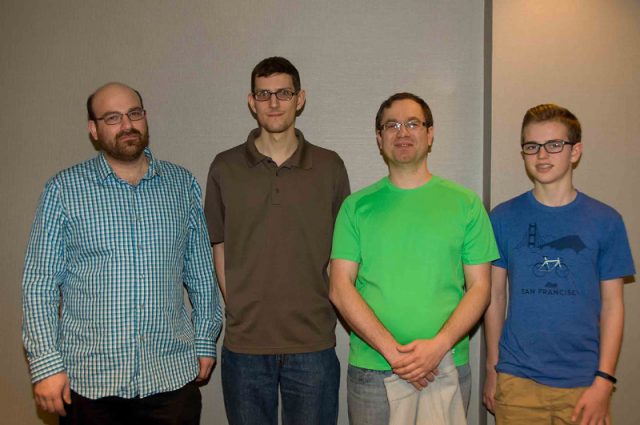 Wisconsin Chess Academy, Photo Betsy Dynako Zacate
Wisconsin Chess Academy, Photo Betsy Dynako Zacate Those losses advanced Talladega Knights and How to Train Your Sicilian Dragon to the top five final slots, along with The Rim Protectors. Also knocked off by the end of the round was Gogica, who went on to win the prize for Top Mixed Doubles (a new category this year, with a strong and youthful team including National Champ Maggie Feng, Jason Wang, Ricky Wang, Marissa Li and Edward Zhang.
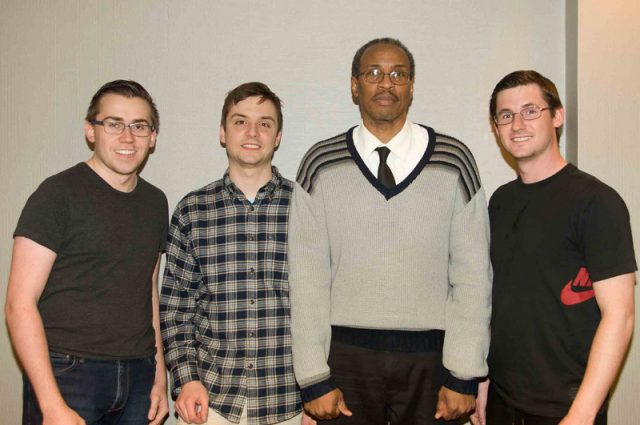 Rim Protectors, Photo Betsy Dynako Zacate
Rim Protectors, Photo Betsy Dynako ZacateGogica lost to Fake Moves, who had the only perfect score going into the final round, where they played white against Nice to Mate You.
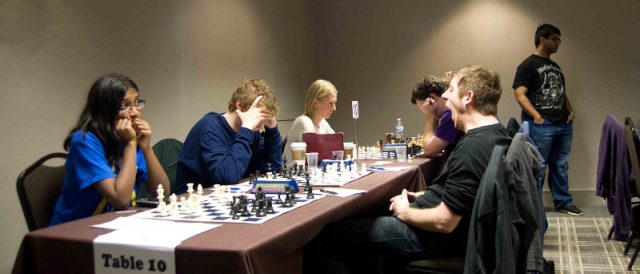 Nice to Mate You vs. Fake Moves, Photo Betsy Dynako Zacate
Nice to Mate You vs. Fake Moves, Photo Betsy Dynako Zacate Fake Moves and Nice to Mate You were comprised of players associated with Webster University of Missouri. Talladega Knights and Fake Moves hailed from Illinois.
 Talladega Knights, Photo Betsy Dynako Zacate
Talladega Knights, Photo Betsy Dynako ZacateThe rival chess states faced off in the final round. How to Train Your Sicilian Dragon, led by IM Eric Rosen, a student at Webster, defeated Talladega Knights. But the battle on first board raged on. Fakes Moves’ first board Sam Schmakle found himself in a heated match with Ashwin Jayaram, when his Nice to Mate You teammate Anna Sharevich, Webster alum, fell to Jonathan Kogen.
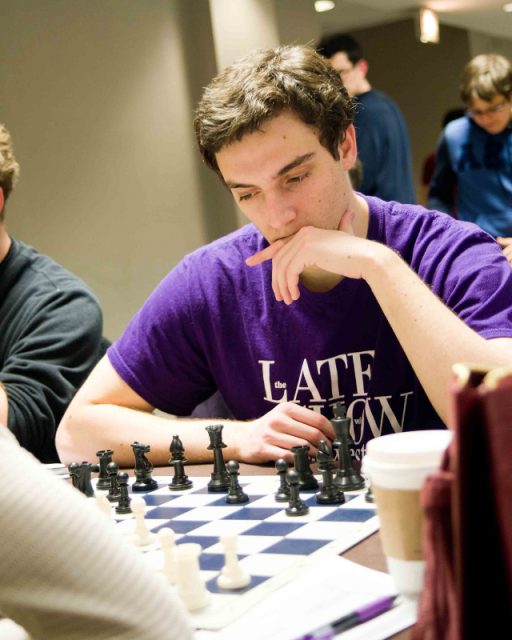 Jonathan Kogen, Photo Betsy Dynako Zacate
Jonathan Kogen, Photo Betsy Dynako Zacate The board one game came down to a queen ending. Schmakel pressed for the win to secure the team title, but Jayaram was able to win tying the match. Fake Moves ended up tied for first with How to Train Your Sicilian Dragon and Fake Moves took the title home on tie breaks. The championship team consisted of Schmakel, Kogen, Michael Auger and Steven Horvath.
The runners-up led by IM Rosen were rounded out by Tansel Turgut, Tom Polgar-Shutzman and Ben Shoykhet.
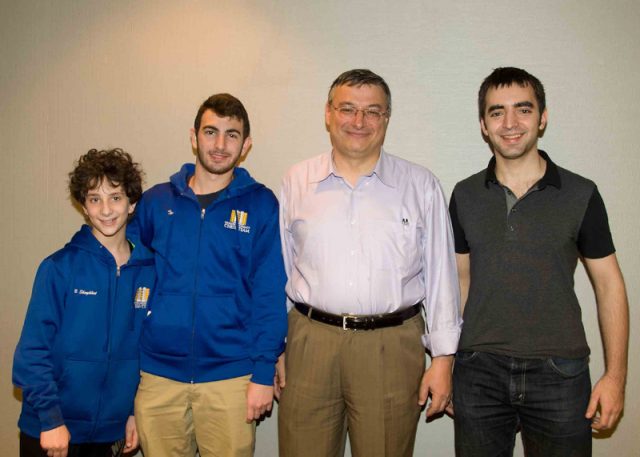 Polgar- Shutzman, Shoykhet, Turgut and Rosen, Photo Betsy Dynako Zacate
Polgar- Shutzman, Shoykhet, Turgut and Rosen, Photo Betsy Dynako ZacateFind full standings from the US Amateur Team North at http://www.chessweekend.com/ and find full MSA rated results here. Find out more about Betsy Dynako's photography here.
Categories
Archives
- December 2025 (24)
- November 2025 (29)
- October 2025 (39)
- September 2025 (27)
- August 2025 (29)
- July 2025 (43)
- June 2025 (25)
- May 2025 (24)
- April 2025 (29)
- March 2025 (29)
- February 2025 (20)
- January 2025 (24)
- December 2024 (34)
- November 2024 (18)
- October 2024 (35)
- September 2024 (23)
- August 2024 (27)
- July 2024 (44)
- June 2024 (27)
- May 2024 (31)
- April 2024 (51)
- March 2024 (34)
- February 2024 (25)
- January 2024 (26)
- December 2023 (29)
- November 2023 (26)
- October 2023 (37)
- September 2023 (27)
- August 2023 (37)
- July 2023 (47)
- June 2023 (33)
- May 2023 (37)
- April 2023 (45)
- March 2023 (37)
- February 2023 (28)
- January 2023 (31)
- December 2022 (23)
- November 2022 (32)
- October 2022 (31)
- September 2022 (19)
- August 2022 (39)
- July 2022 (32)
- June 2022 (35)
- May 2022 (21)
- April 2022 (31)
- March 2022 (33)
- February 2022 (21)
- January 2022 (27)
- December 2021 (36)
- November 2021 (34)
- October 2021 (25)
- September 2021 (25)
- August 2021 (41)
- July 2021 (36)
- June 2021 (29)
- May 2021 (29)
- April 2021 (31)
- March 2021 (33)
- February 2021 (28)
- January 2021 (29)
- December 2020 (38)
- November 2020 (40)
- October 2020 (41)
- September 2020 (35)
- August 2020 (38)
- July 2020 (36)
- June 2020 (46)
- May 2020 (42)
- April 2020 (37)
- March 2020 (60)
- February 2020 (38)
- January 2020 (45)
- December 2019 (34)
- November 2019 (35)
- October 2019 (42)
- September 2019 (45)
- August 2019 (56)
- July 2019 (44)
- June 2019 (35)
- May 2019 (40)
- April 2019 (48)
- March 2019 (61)
- February 2019 (39)
- January 2019 (30)
- December 2018 (29)
- November 2018 (51)
- October 2018 (45)
- September 2018 (29)
- August 2018 (49)
- July 2018 (35)
- June 2018 (31)
- May 2018 (39)
- April 2018 (31)
- March 2018 (26)
- February 2018 (33)
- January 2018 (30)
- December 2017 (26)
- November 2017 (24)
- October 2017 (30)
- September 2017 (30)
- August 2017 (31)
- July 2017 (28)
- June 2017 (32)
- May 2017 (26)
- April 2017 (37)
- March 2017 (28)
- February 2017 (30)
- January 2017 (27)
- December 2016 (29)
- November 2016 (24)
- October 2016 (32)
- September 2016 (31)
- August 2016 (27)
- July 2016 (24)
- June 2016 (26)
- May 2016 (19)
- April 2016 (30)
- March 2016 (36)
- February 2016 (28)
- January 2016 (32)
- December 2015 (26)
- November 2015 (23)
- October 2015 (16)
- September 2015 (28)
- August 2015 (28)
- July 2015 (6)
- June 2015 (1)
- May 2015 (2)
- April 2015 (1)
- February 2015 (3)
- January 2015 (1)
- December 2014 (1)
- July 2010 (1)
- October 1991 (1)
- August 1989 (1)
- January 1988 (1)
- December 1983 (1)







